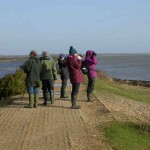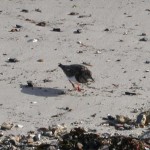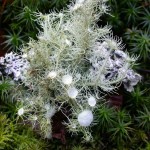On Sunday 27th January, Martin Sell led a joint field trip with the Berkshire, Buckinghamshire and Oxfordshire Wildlife Trust (BBOWT) to Pennington Marshes and the New Forest. The morning was sunny, following heavy overnight rain. On the journey down, the River Test near Southampton and the Lymington River at Brockenhurst were both in flood and Pennington Lane too was flooded in places. There were Oystercatchers, Curlews, Lapwings, Redshanks and Brent Geese in the field to the north of the lane, while the flooded field to the south had many Wigeon, plus a few Pintail, Teal and Shoveler. The group walked out to the sea wall, where the tide was high. A flock of about 20 Turnstones were busily picking over the seaweed at the base of the wall. Out in the Solent, first one, then four, Slavonian Grebes were spotted. They had smart black caps and white necks, and through the telescope, it was even possible to see their red eyes. The Great Crested Grebe which swam up to join them was noticeably bigger. Next, a flock of about six Red-breasted Mergansers was spotted. Their jagged crests could be picked out with the help of the telescope. A small grey bird with black legs at the base of the sea wall was identified as a Rock Pipit. The big pool on the landward side of the wall had a Little Egret and a number of Shelduck and Teal, together with a large flock of chuckling Brent Geese.
After lunch, Martin’s route through Brockenhurst to the final destination, Blackwater Arboretum in the New Forest, included the crossing of a perilously deep ford. On arrival, a Song Thrush was foraging next to the car park and a fallen twig was covered in an interesting collection of lichens. Some of the trees in the arboretum, including in particular a Common Pear, were also draped in lichens. A single Siskin was seen and then the first of the Hawfinches flew in. Over the next hour or so, one or occasionally two Hawfinches would perch on the top of a tall conifer near the centre of the arboretum. Illuminated by the late afternoon sun, they would stay in the same position for several minutes at a time, giving excellent views through the telescope. It was impossible to tell whether two or half a dozen birds were seen. On the drive back to Reading, one group had the good fortune to spot a Barn Owl on a fence post next to the road.



